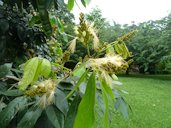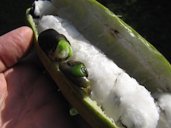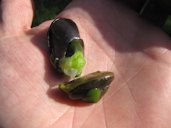| Pacay - Inga feuillei | |||||||||||||
|---|---|---|---|---|---|---|---|---|---|---|---|---|---|
|
Back to Inga Species Page 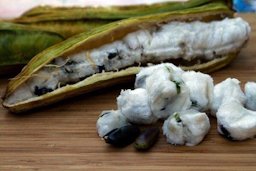 Fig. 1  Pacay, Inga feuillei 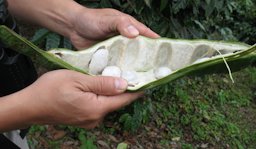 Fig. 2  Seedpod opened to reveal the sweet white flesh 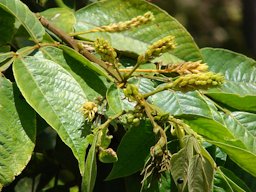 Fig. 3  I. feuillei (Ice cream bean). Leaves and immature flowers. Kula, Maui, Hawai'i. 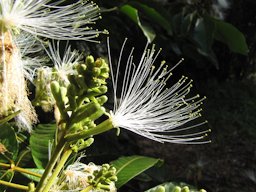 Fig. 4  I. feuillei (Ice cream bean). Flowers. Enchanting Floral Gardens of Kula, Maui, Hawai'i. 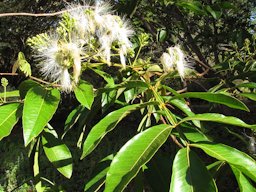 Fig. 5  I. feuillei (Ice cream bean). Flowers and leaves. Enchanting Floral Gardens of Kula, Maui, Hawai'i. 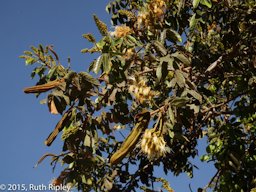 Fig. 7  I. feuillei, Carhuaz, Ancash, Peru. 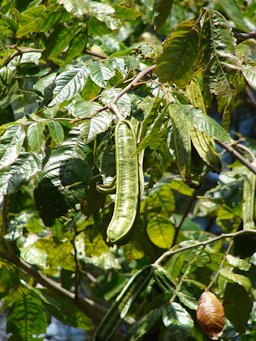 Fig. 8  Leaves and seedpods. Olinda, Maui, Hawai'i. 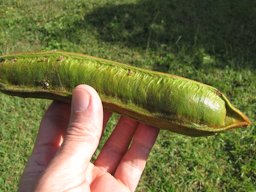 Fig. 9  Fruit. Makawao, Maui, Hawai'i. 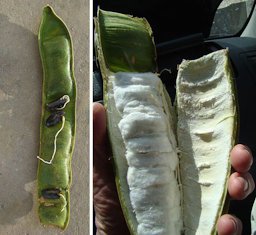 Fig. 10  I. feuillei, the Peruvian ice cream bean. Native to the Andes from Columbia to Peru and known as Pacay. The white pulp is a sweet treat. 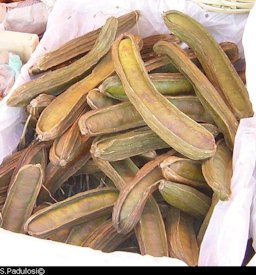 Fig. 16  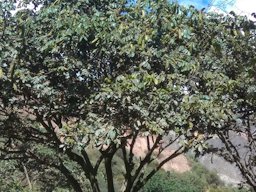 Fig. 17  I. feuillei, Pedro Domingo Murillo, BO-LP, Bolivia. 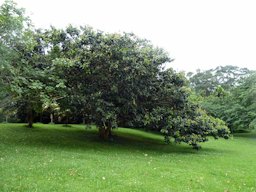 Fig. 18  I. feuillei, Ho'omaluhia Botanical Garden, Kane'ohe, Oahu. 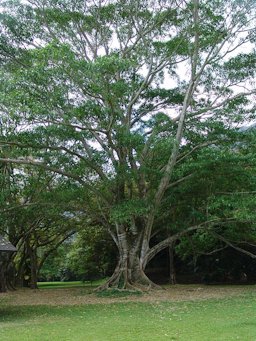 Fig. 19  Pacay (I. feuillei), Ho'omaluhia Botanical Garden, Oahu Hawai'i 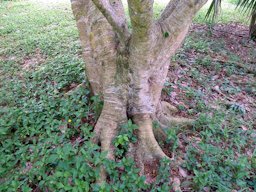 Fig. 20 Trunk of the I. feuillei, Ho'omaluhia Botanical Garden, Kane'ohe, Oahu. 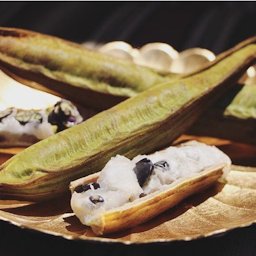 Fig. 21 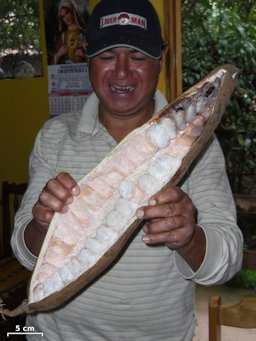 Fig. 22 A rather large seedpod 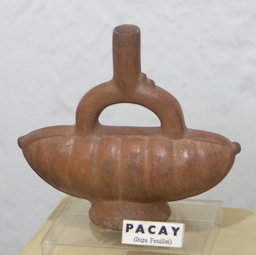 Fig. 23  Ceramic vessel shaped like the pacay. Seen at the Archaeological Museum that is part of the Conjunto Monumental Belén in Cajamarca, Peru. Back to Inga Species Page |
Scientific
name Inga feuillei DC. Common names Quechua: pa'qay, paccai (Cuzco); Aymara: pa'qaya; Spanish: pacay, pacae, pacay de Perú, guama, guamo; English: ice-cream beans, food inga; French: pois sucre; Portuguese: ingá cipó, rabo de mico 2 Synonyms I. cumingiana Benth., I. edulis sensu auct. (Misapplied), I.feuillei DC. (Spelling variant) 4 Relatives I. vera; I. edulis, I. paterno, I. cinnamomea; I. capitata, I. velutina, I. macrophylla, I. alba; carob, Ceratonia siliqua; tamarind, Tamarindus indica; Guamuchil, Pithecellobium dulce Family Fabaceae⁄Leguminosae (pea family) Origin Andean valleys of northwestern South America 2 USDA hardiness zones 10-12 Uses Food; shade; living fence; erosion control; wood products 2 Height Normally less than 50 ft (15 m); can reach up to 130 ft (40 m) 2 Plant habit Either evergreen or deciduous 5 Growth rate Rapid Longevity Short lived (20 years) 5 Pruning requirement Pollarding is recommended Leaves Dark green; large; oval leaflets in pairs with a terminal one 5 Flowers Fragrant; sessile, pentamerous and are arranged in axillary spikes 5 Fruit Pendant, indehiscent pod; straight or curved, green or brownish-yellow; up to 28 in. (70 cm) long; green seeds 2,5 Soil tolerances Adaptable to a wide range of soils; better growth rates on clayey or loamy soils 5 pH preference 4.0-8.0 2,5 Invasive potential * None reported Pest resistance Generally resistant to pests Known hazard None known Origin Most commonly called “pacay” and “guama,” this particular inga has long been popular. Its pods are depicted in ancient ceramics. The Incas had pacay pods carried to their mountain capital of Cuzco. Pedro Pizarro reports that the Inca emperor Atahualpa sent to Francisco Pizarro a basketful of guamas as a gift. Inga pods are portrayed on pre- Columbian pottery (Fig. 24), and their pods and seeds have been found in tombs dating back to about 1000 B.C. 2 It is widely grown in highland valleys as well as in coastal lowlands of Peru and Ecuador where it is often employed as a shade tree or street tree. 2 The species also has been introduced to other areas in Central and South America and elsewhere including Australia and Malaysia. 5 Description All legumes have their seeds encased in pods, and a few of these pods are widely eaten as vegetables—green beans and snow peas, for example. A few lesser known legumes produce pods containing a sweet, mealy pulp and are eaten as fruits. Carob, tamarind, and honey locust are the best known. However, trees of the genus Inga also produce sweet pods. They deserve much greater recognition and could become widely known and enjoyed. 2 Inga feuilleei (named after Louis Feuillée), commonly known as pacay or ice-cream bean tree, is a tree in the family Fabaceae native to Andean valleys of northwestern South America. Pacay trees, as is the case with other trees in genus Inga, also produce pods that contain an edible white pulp and have nitrogen-fixing roots. 2 This species is more subtropical but share similar agro-ecological requirements as for Inga edulis. 5 Inga species are usually small trees, normally less than 50 ft (15 m), although some of them can reach up to 130 ft (40 m). 2 Leaves The simply pinnate, dark-green leaves have large, oval leaflets in pairs without a terminal one. Many species have a green wing (rachis) between each pair of leaves. There is a nectary (small pit containing nectar) between each pair of leaves. Ants frequent these nectaries and probably play an important role in protecting the trees from insect pests such as aphids. 2 Flowers The fragrant flowers are arranged in crowded heads, spikes, or panicles at the stem tips or axils. Because they are rich in nectar, they attract bees, hummingbirds, and a variety of beetles. All species studied so far are self-incompatible, they need at least two genetically different individuals for fruit set. 2
Fig. 6. Flowers of the I. feuillei at Ho'omaluhia Botanical Garden in Kane'ohe, Oahu Fruit Fruit begins to mature a few months after pollination, and production may be nearly continuous (twice a year in I. feuillei in the Andes). The pods may be flat, twisted, or cylindrical. They are often flattened or four-sided, the margins frequently overhanging. They grow up to 28 in. (70 cm) long and ½-2 in. (1–3 cm) in diameter, usually with the green seeds buried in the white, sweet pulp. 2
Fig. 11 I. Feuillei, Ho'omaluhia Botanical Garden, Kane'ohe, Oahu Fig. 12. Pacay Peruvian fruit Fig. 13. Seeds, aril (edible) and portion of I. feuilleei pod Fig. 14,15. Fruit showing pulpy seeds, Makawao, Maui, Hawai'i Harvesting Fruit usually matures a few months after pollination. 2 Pollination Bees, hummingbirds, and a variety of beetles. 2 Propagation Generally propagated through seeds. Seeds usually start germinating in the pod (Fig. 10 ) when the testas are ripe. The best method of propagation is using plastic bags 15 cm wide and 20 cm high, filled with soil. If enough seed is available, two should be planted in each bag, eliminating the smaller of the two in case both germinate. Bags should be placed under shade with periodic watering to maintain the soil humid. Germination will occur in 1-2 weeks. The plants will be ready for the definitive transplant when 30-40 cm high after around 3-4 months. During this period, shade must be progressively eliminated. 6 Planting In silviculture, they are usually planted from seedlings grown in nurseries. 2 Pollarding The trait is exceptionally valuable. In pollarding, the tree is pruned to 6.5-10 ft (2–3 m) (that is, just above the reach of grazing livestock). The tree then puts out a dense flush of new growth. In coppicing, the tree is cut near its base, and its stump regenerates new shoots. Both management systems allow repeated and frequent harvest of wood without the cost and effort of replanting seedlings each time. 2 Fertilizing Naturally growing Inga trees produce abundant root nodules, which fix nitrogen, thus adding nitrogen to the soil rather than taking it away, hence benefitting the land by increasing fertility levels. 3 I. edulis and I. feuillei nodulate profusely even at pH 4.5 and are also heavily mycorrhizal (vesicular arbuscular mycorrhizae). These mycorrhizae play an important role in enabling ingas to take up phosphorus even though phosphorus is in very short supply in acid soils. 2 Food Uses Most ice cream beans are eaten fresh. They are merely split open and the pulp dipped out with the fingers. However, ice-cream beans can also be handled as a processed product. They are washed and split and the contents removed and strained to separate the pulp from the seeds. Although pleasing, the pulp is not particularly nutritious. It contains about 1 percent protein and 15 percent carbohydrate, mainly sugar. 2 Medicinal Properties ** Similar to I. edulis Other Uses • They are multipurpose trees and are potentially valuable additions to gardens, orchards, fields, hedgerows, or wayside wastelands throughout the tropics. • They also have excellent prospects as urban trees. In Mexico, coffee-plantation workers can double their annual salary by selling the pods from the Inga trees used to shade the coffee plants. • Its wood can be used for furniture, boxes, crates, light construction, and general carpentry and also for firewood. • Fuel. Inga wood makes excellent fuel and is utilized for charcoal throughout the West Indies. Certain species pollard and coppice well. • Shade. Inga species grow rapidly and are common shade trees used on coffee and cacao plantations in Central America and the West Indies, where their cultivation and characteristics are well established. • Soil Improvement and Intercropping. Like most legumes, inga trees fix nitrogen and improve the soil around them. 2,5 Other Edible Inga Species General Pacay (pacae) is a Quechua word used in Spanish specifically for the upland Andes species. “Guama” or “guaba” are names widely used for any Inga species whose pods have sweet pulp. 2 List of Growers and Vendors |
||||||||||||
| Bibliography 1 "Taxon: Inga feuillei DC." USDA, Agricultural Research Service, U.S. National Plant Germplasm System, GRIN-Global, npgsweb.ars-grin.gov/gringlobal/taxonomydetail.aspx?id=406665. Accessed 28 May 2020. 2 "Lost Crops of the Incas: Little-Known Plants of the Andes with Promise for Worldwide Cultivation." National Research Council (U.S.), Advisory Committee on Technology Innovation, 1989, ETDF, epdf.pub/lost-crops-of-the-incas-little-known-plants-of-the-andes-with-promise-for-worldw.html. Accessed 28 May 2020. 3 "Inga feuillei". Wikipedia, en.wikipedia.org/wiki/Inga_feuilleei. Accessed 28 May 2020. 4 "Synonyms for Inga feuillei DC." The Plant List (2013), Version 1.1, www.theplantlist.org. Accessed 28 May 2020. 5 Lim T. K. "Edible Medicinal And Non-Medicinal Plants: Volume 2, Fruits." EPDF, 2012, epdf.pub/volume-2-fruits.html. Accessed 1 June 2020. 6 Valle, Guillermo. "Inga alley cropping manual." Manual of Inga Agroforestree, 2010, Rainforest Saver, www.rainforestsaver.org/inga-alley-cropping-manual. Accessed 7 June2020. Photographs Fig. 1,22 Ivan. "Ever take an ice cream bean for dessert?" Random Times, Public Domain, random-times.com/2018/07/18/ever-take-an-ice-cream-bean-for-dessert/. Accessed 7 Apr. 2020. Fig. 2 Vilseskogen. "Seedpod opened to reveal the sweet white flesh." Tropical Plants Database, (CC BY 2.0), tropical.theferns.info/viewtropical.php?id=Inga+edulis. Accessed 6 Apr. 2020. Fig. 3 Starr, Forest and Kim. "Inga feuillei (Ice cream bean). Leaves and immature flowers. Kula, Maui, Hawai'i." Starr Environmental, no. 090519-804919, May 2009, (CC BY 4.0), starrenvironmental.com/images/image/?q=24929385276. Accessed 29 May 2020. Fig. 4 Starr, Forest and Kim. "Inga feuillei (Ice cream bean). Flowers. Enchanting Floral Gardens of Kula, Maui, Hawai'i." Starr Environmental, no. 120301-3181, 1 Mar. 2012, (CC BY 4.0), starrenvironmental.com/images/image/?q=120301-3181. Accessed 29 May 2020. Fig. 5 Starr, Forest and Kim. "Inga feuillei (Ice cream bean). Flowers and leaves. Enchanting Floral Gardens of Kula, Maui, Hawai'i." Starr Environmental, no. 120301-3183, 1 Mar. 2012, (CC BY 4.0), starrenvironmental.com/images/image/?q=25018590242. Accessed 29 May 2020. Fig. 6 Cutler, Wendy. "Flowers of the Inga Feuillei at Ho'omaluhia Botanical Garden in Kane'ohe, Oahu." Flickr, 10 Nov. 2010, (CC BY-SA 2.0), www.flickr.com/photos/wlcutler/5195992872/in/photostream/. Accessed 29 May 2020. Fig. 7 Ripley, Ruth. "Inga feuilleei, Carhuaz, Ancash, Peru." iNaturalist Research Grade Observations, Observed 7 June 2015, Submitted 18 Apr. 2018, (CC BY-NC 4.0), www.inaturalist.org/observations/11122572. Accessed 4 June 2020. Fig. 8 Starr, Forest and Kim. "Inga feuillei (Ice cream bean). Leaves and seedpods. Olinda, Maui, Hawai'i." Starr Environmental, no. 070328-6185, 28 Mar. 2007, (CC BY 4.0), starrenvironmental.com/images/image/?q=24257803264. Accessed 29 May 2020. Fig. 9 Starr, Forest and Kim. "Inga feuillei (Ice cream bean). Fruit. Makawao, Maui, Hawai'i." Starr Environmental, no. 130429-4293, 29 Apr. 2013, (CC BY 4.0), starrenvironmental.com/images/image/?q=25092200002. Accessed 29 May 2020. Fig. 10 Culbert, Dick. "Inga feuillei, the Peruvian Icecream Bean. Native to the Andes from Columbia to Peru and known as Pacay. The white seed coating is a sweet treat." Wikimedia Commons, 5 Oct. 2013, (CC BY 2.0), commons.wikimedia.org/wiki/File:Inga_feuillei,_the_Peruvian_Icecream_Bean_(10108338474).jpg. Accessed 29 May 2020. Fig. 11 Cutler, Wendy. "Inga Feuillei at Ho'omaluhia Botanical Garden in Kane'ohe, Oahu." Flickr, 8 Dec. 2015, (CC BY-SA 2.0), www.flickr.com/photos/wlcutler/23723846051/in/photostream/. Accessed 29 May 2020. Fig. 12 Paolo*torino. "Pacay Peruvian fruit." Wikimedia Commons, 6 Mar. 2016, (CC BY-SA 4.0), commons.wikimedia.org/wiki/Category:Inga_feuilleei#/media/File:Pacay_Peruvian_fruit1.JPG. Accessed 4 June 2020. Fig. 13 Lichinga. "Seeds, aril (edible) and portion of Inga feuilleei pod." Wikimedia Commons, 6 Mar. 2016, (CC BY-SA 4.0), commons.wikimedia.org/wiki/Category:Inga_feuilleei#/media/File:Inga_(arillo_e_sementi).JPG. Accessed 4 June 2020. Fig. 14 Starr, Forest and Kim. "Inga feuillei (Ice cream bean). Fruit showing pulpy seeds. Makawao, Maui, Hawai'i." Starr Environmental, no. 130429-4297, 28 Apr. 2013, (CC BY 4.0), starrenvironmental.com/images/image/?q=130429-4297. Accessed 29 May 2020. Fig. 15 Starr, Forest and Kim. "Inga feuillei (Ice cream bean). Seeds. Makawao, Maui, Hawai'i." Starr Environmental, no. 24842800419, 28 Apr. 2013, (CC BY 4.0), starrenvironmental.com/images/image/?q=24842800419. Accessed 29 May 2020. Fig. 16 Gadulosi, S. "Fabaceae Inga feuillei." New World Fruits Database, Biodiversity International, (CC BY 4.0), nwfdb.bioversityinternational.org/detail/?uid_fruit=553. Accessed 4 June 2020. Fig. 17 rosaiselameneses. "Inga feuilleei, Pedro Domingo Murillo, BO-LP, BO." iNaturalist Research Grade Observations, City Nature Challenge 2019, 26 Apr. 2019, (CC BY-NC 4.0), www.inaturalist.org/observations/23299814. Accessed 4 June 2020. Fig. 18 Cutler, Wendy. "Inga Feuillei at Ho'omaluhia Botanical Garden in Kane'ohe, Oahu." Flickr, 10 Nov. 2010, (CC BY-SA 2.0), www.flickr.com/photos/wlcutler/5195992872/in/photostream/. Accessed 29 May 2020. Fig. 19 Avery, Drew. "Pacay (c) in Ho'omaluhia Botanical Garden Oahu Hawai'i." Wikimedia Commons, via Flickr, 16 May 2009, (CC BY 2.0), commons.wikimedia.org/wiki/Category:Inga_feuilleei#/media/File:Pacay_(Inga_feuillei).jpg. Accessed 4 June 2020. Fig. 20 Cutler, Wendy. "Trunk of the Inga Feuillei at Ho'omaluhia Botanical Garden in Kane'ohe, Oahu." Flickr, 10 Nov. 2010, (CC BY-SA 2.0), www.flickr.com/photos/wlcutler/5195385925/in/photostream/. Accessed 29 May 2020. Fig. 21 Hollinger, Jason. "A rather large seedpod." Tropical Plants Database, (CC BY 2.0), tropical.theferns.info/viewtropical.php?id=Inga+edulis. Accessed 6 Apr. 2020. Fig. 23 A.Davey. "Ceramic vessel shaped like the pacay. Seen at the Archaeological Museum that is part of the Conjunto Monumental Belén in Cajamarca, Peru." Flickr, 15 July 2016, (CC BY-NC-ND 2.0), www.flickr.com/photos/adavey/29192148152. Accessed 4 June 2020. * UF/IFAS Assessment of Non-native Plants in Florida's Natural Areas ** Information provided is not intended to be used as a guide for treatment of medical conditions. Published 3 Nov. 2020 LR |
|||||||||||||
